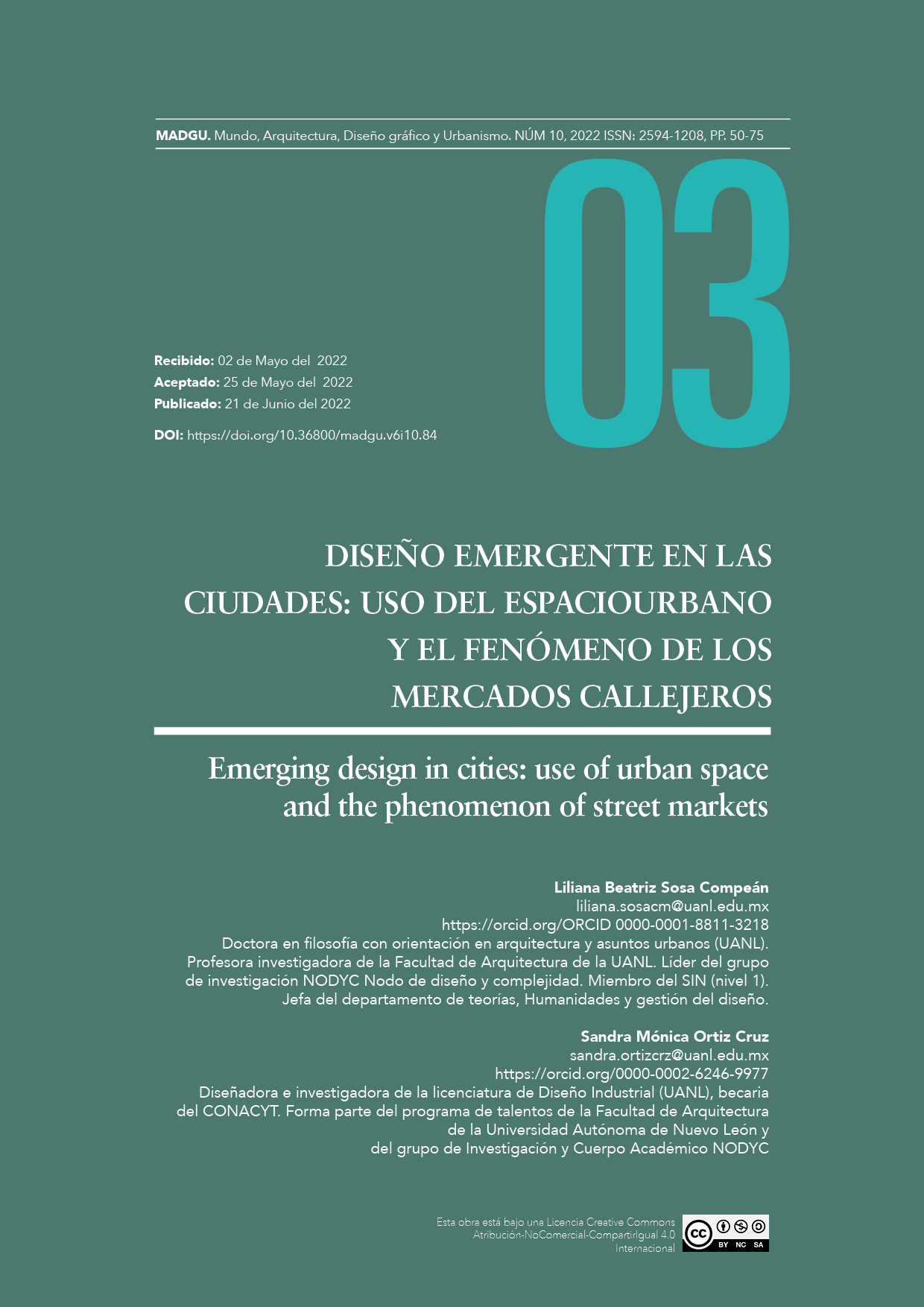Emerging Design in Cities: Use of Urban Space and the Phenomenon of Street Markets
DOI:
https://doi.org/10.36800/madgu.v6i10.84Keywords:
Street markets, urban space, objects in the markets, urban dynamics, emerging designAbstract
Street markets represent a social phenomenon that triggers the emergence of identities, configuration and use of spaces from the interaction of people, objects and their environment. The present document deals with the emergence of urban design and the self-production of public space as a consequence of the social organization that sustains street markets. In the first instance, a theoretical foundation of the perspective of complex systems used to address the phenomenon is established; then street markets are explored from different perspectives: the activities, motives and customs of the people who produce them and interact in them, as well as an analysis, in case studies, of their structure and dynamics of the use of streets and built spaces, in order to reflect on its emergence, benefits and potential for use in urban systems. The nature of this study is qualitative, exploratory and descriptive, aimed at establishing general guidelines for intervention with design in street markets in order to take advantage of them as systems that improve the experience of inhabiting the city.
Downloads
References
Cambiaso, A. (2017). Nuevas configuraciones espaciales del habitar migrante : el caso de la calle Marurí, barrio norte histórico de La Chimba, Independencia. Recuperado de: https://bibliotecadigital.uchile.cl/discovery/fulldisplay/alma991007447422603936/56UDC_INST:56UDC_INST
C40 Cities Climate Leadership Group y C40 Knowledge Hub. (2020). How to Build Back Better with a 15-Minute City. Recuperado de: https://www.c40knowledgehub.org/s/article/How-to-build-back-better-with-a-15-minute-city?language=en_US
C40 Knowledge Hub. (2021). Why every city can benefit from a ‘15-minute city’ vision. Retrieved from https://www.c40knowledgehub.org/s/article/Why-every-city-can-benefit-from-a-15-minute-city-vision?language=en_US
Delgado J. y Ramirez,B., (1999) Transacciones: La nueva formación territorial de la Ciudad de México . Universidad Autónoma Metropolitana/ Plaza y Valdés, México.
Larson, K. (2012). Diseños brillantes para adaptarse a más personas en cada ciudad. [Video] Conferencias TED. https://www.ted.com/talks/kent_larson_brilliant_designs_to_fit_more_people_in_every_city?language=en
Lazo P. (2006). Ensamblaje de México; Los mercados sobre ruedas como alternativa de espacio público . Revista Arquine No.36. Recuperado de: https://www.arquine.com/wp-content/uploads/2017/08/Arq36.analisis-a.pdf
Moreno,C., Allam, Z., Chabaud, D., Gall, C. y Pratlong,F. (2021). Introducing the “15-Minute City”: Sustainability, Resilience and Place Identity in Future Post-Pandemic Cities. DOI: https://doi.org/10.3390/smartcities4010006
OECD. OECD Policy Responses to Coronavirus (Covid-19): Cities Policy Responses; OECD: Paris, France, 2020.
Rocha, L., 2019. Comunidad: un elemento esencial de la identidad urbana. Revista Código | Arte, Arquitectura, Diseño, Cine,(2019, Septiembre 11). Recuperado de : https://revistacodigo.com/comunidad-identidad-urbana/
Rodriguez, E. (2020). Apropiación del espacio público: Tianguis El Piojo (Gran Bazar Siglo XXI) Municipio de Toluca, Estado de México. URI: http://hdl.handle.net/20.500.11799/109455
Sandoval E. (2020) ¿Por qué la gente compra fayuca en los tianguis de Monterrey? . DOI https://doi.org/10.24275/uam/izt/dcsh/alt/2020v30n60/sandoval
Sosa, L. (2020).Nociones sobre Diseño complejo. Editorial Labyrinthos y UANL. Recuperado de: http://eprints.uanl.mx/id/eprint/21237
UN-Habitat. Un-Habitat Key Message on Covid-19 and Public Space; UN-Habitat: Nairobi, Kenya, 2020.
Urrego, M. y Ocampo, C. (2021). La complejidad: una perspectiva filosófica y multidisciplinar en las ciudades inteligentes. DOI: https://doi.org/10.35575/rvucn.n64a11
Verel, K. (2020). Seven Principles for Becoming a Market City. Projects for public spaces. https://www.pps.org/article/seven-principles-for-becoming-a-market-city
Verel, K., & Wheeler, K. (2020). Toward Market Cities: Lessons on Supporting Public Market Systems From Pittsburgh, Seattle, and Toronto. New York, NY: Project for Public Spaces. https://assets-global.website-files.com/581110f944272e4a11871c01/5f8a1688ba4f455a339c1208_2020-1016%20MC%20Pilot%20Project%20Summary.pdf
Vidal, T., y Pol, E. (2005). La apropiación del espacio: una propuesta teórica para comprender la vinculación entre las personas y los lugares.Anuario de Psicología, 33(3), 281-297.
Weng, M., Ding, N., Li, J., Jin., X., Xiao, H., He, Z. y Su, S. (2019). The 15-minute walkable neighborhoods: Measurement, social inequalities and implications for building healthy communities in urban China. Journal of Transport and Health. DOI. https://doi.org/10.1016/j.jth.2019.05.005
WHO, World Health Organisation. The World Health Organisation Quality of Life (WHOQOL); World Health Organisation: Geneva, Switzerland, 2012.

Downloads
Published
Versions
- 2022-06-21 (2)
- 2022-06-21 (1)
How to Cite
Issue
Section
License
Copyright (c) 2022 Sandra Mónica Ortiz Cruz, Liliana Beatríz Sosa

This work is licensed under a Creative Commons Attribution-NonCommercial-ShareAlike 4.0 International License.
Las opiniones expresadas por los autores no necesariamente reflejan la postura del editor de la publicación. Esta obra está bajo una Licencia Creative Commons Atribución-NoComercial-CompartirIgual 4.0 Internacional.








